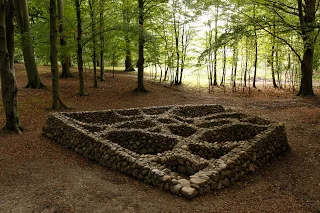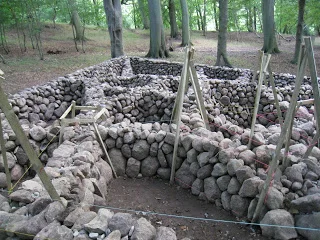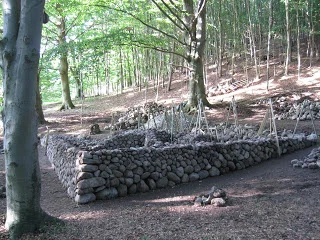I’m delighted by this new-found perspective which has been amplified this past week by my being in Bend, Oregon. The city of 80,000 has doubled its population in the past 20 years. The increase is due in large measure by the influx of people like Jeff Fairfield and his wife Samantha. Both Maine natives, they moved to the Bend area 6 years ago to begin their careers building dry stone walls and teaching horseback riding. Jeff’s joining me on the Tarriance at COCC this week got the project off to a great start. After taking delivery on 15 tons of stone we made full-scale, foam board, mock-ups of the individual pieces. With them I could quickly try out different granite slab and basalt boulder arrangements.
Read MoreThe last five pages of my notebook are covered in boulder sketches. Each one records the shape and dimensions of a large stone in Edward Tufte’s growing stock yard of material pried loose from ledges on his Hogpen Hill Farm. The pencil sketches are the first step in a method of discovery I’ve employed for designing megalithic constructions since 1981 when I won a NEA grant for studying amphitheaters. From the drawings I fashion ¼” -1’ clay models of the stones. With the clay pieces I can try out a variety of construction configurations before confronting the actual boulders. The small-scale assemblages allow for freedom to experiment with different design concepts.
Read MoreWhen I began building stone features on Richard Epstein’s property more than ten years ago he had a unformed, but long term vision of the space around his cabin. He wanted to keep the sequestered feel of being in the deep woods. He also wanted to armor the slopes surrounding his home with stone. To this end, we began by building a sunken patio to the southeast with stepped paths leading to a pond. A few years later, a raised pyramid, fire pit patio was created to the northeast. Stone steps replaced wood stairs at porch entrances.
Read More"Working hands inform thought and awaken understanding of the art builder's place in the natural world. Undulant lines and patterned spaces are the result of many choices made by the builder who recognizes, and utilizes, the unique character of stone"
- Dan Snow
My time in the eye of the stone has passed. Yesterday saw the final vertical pieces set in the Horse Eye sculpture. Phase One is complete except for two elements being carved by Chris Curtis of West Branch Gallery in Stowe, Vermont. They will be lowered into place at a later date, replacing the styrofoam mock-ups. The carved pieces will represent the “third eyelid.” The third eyelid of a horse is the lightning-fast flap that zips across from the inner corner to seal the eye shut against threat even before the lids can close. It's also the source of lubricating tears.
Read MoreTrick-or-treaters had the trick played on them this autumn when a pre-Halloween Nor’easter dropped a foot of snow on our area. Witches and goblins don’t usually have to scale snowbanks to ring doorbells. And I don’t expect my stone supplies to disappear under a blanket of white stuff in October. But after a short delay, the project I had scheduled for last week got underway and a 100’ length of “singling” was produced for Cochecho Country Club. This style of dry stone walling is well suited to a materials supply constituted of boulders. The stone was resurrected from the remnants of an old field wall. The wall line was reestablished and a crushed-stone base installed.
Read MoreWhen I built this wall in Jamaica, Vermont, thirty-odd years ago, my concern for its longevity came out of its close proximity to the road. I expected a car might back into it, or the snow plow jostle it. The notion that Ball Mountain Brook might one day destroy it never crossed my mind. But that’s just what happened a month ago when rain from Hurricane Irene turned the mild stream into a raging cataract. Brook waters tore away the bank, sweeping away not only a section of the stone wall but half the house, as well.
Read MoreCongratulations go out to Brian Post on his successful completion of Part A of the DSWA Level 3 certification test. Brian chose the ‘lunky hole’ feature to build alongside the mandatory curved wall section. He built his test pieces at the Stone Trust indoor training and testing facility in Dummerston, Vermont.
Read MoreStone I harvested back in July got a work-out this week in the construction of a small foundation for a neighbor. Even before the new woodshed was completed, its builder was contemplating the addition of a space to store yard carts. Consequently, I was asked to build a dry stone foundation off the south end of the structure. Two wood posts, anchored to the granite sill-stones, will support a beam and rafters attached to the side of the building. The mass of the stone work visually establishes the woodshed in the landscape, and its top surface functions as a rugged floor for the cart shed.
Read More“Diamond Mines” is an abstract, site-specific sculpture built of loose, natural stone. The work is situated on westward-sloping ground in a grove of mature beech trees. Wooded hills rise to the north and south. Park paths wind along the west and north sides of the sculpture. To the west, Tranekær lake and castle can be viewed. ‘Diamond’ is the perimeter, outline shape of the sculpture. The shapes of the nineteen interior facets are also diamond. There are a total of eighty-five obtuse and acute angles in the sculpture. The stones are set on their near-vertical axis in the construction, pointing up and down in the wall faces. In “Diamond Mines” there are diamonds within diamonds within a diamond.
Read MoreThe building of “Diamond Mines” was a delightful experience due to the many wonderful people who helped make it possible. Thanks go to my new Danish friends; Alfio, Lone, Ole, Birthe and Trine. To on-site workers Francesca and Jared goes my grateful appreciation. Always behind the scenes and in the middle of it all was Elin, who supported me in every moment and was my guiding light at every turn.
Read MoreThis song, from Mark Knopfler and Emmylou Harris’s “All the Roadrunning” album, makes a good anthem for those of us who grub our living out of the ground. We stone workers labor to lift something special from the earth. Our efforts are mainly brutish and blunt but we continue day by day in the belief that something beautiful will arise in the end. When it finally does, the light of what we’ve created shines briefly before for us. And then we must turn our backs and leave it all behind.
Read MoreAbout once an hour, or so, someone walks by the site and asks me what I’m doing. Often they wonder if I am repairing something. I’ve been told the piece looks like a temple, fishponds, and human tissue under a microscope. “How long before it’s finished?” and, “What’s it called?” are the common follow-up questions after they hear I’m building a new abstract sculpture for TICKON art-park. I can now say that it will be finished in a few days, and that the piece is called “The Diamond Mines.” It’s been a rare experience for me; spending these past weeks in a grove of stately old beach trees. Plus, daily visits from Elin, and picnics with her Danish family, have quickly turned this project into an all-time personal favorite.
Read MoreWorking hands inform thought and awaken understanding of the art builder's place in the natural world. Undulant lines and patterned spaces are the result of many choices made by the art builder who recognizes, and utilizes, the unique character of stone. The presentation will examine the many uses of stone in art; how stone can support a design, or simply be the art itself. It will also explore the "give and take" experience of working in nature, and the connection to spirit expressed through stone.
Read MoreThe TICKON installation is past the halfway mark thanks to the help of Alfio Bonnano and Ole Johnsen who have coordinated all the logistics of tools and materials, plus, made us feel at home away from home. On site, Francesca and Jared have put in long hours raising the walls of the piece that will soon be the newest addition to the art park. Elin has been busy orchestrating the myriad details of working and living away from Vermont, and documenting the process and progress of the installation.
Read MoreWhile the supply was drying out I began setting up batter frames. Each board describes an inside corner of the construction. Because the wall intersections are many different obtuse and acute angles, each board is set to correspond to the intersection angle and to the wall batter. The wall batter is 2.5” in every 12” of vertical height. Work on the piece begins at the center and moves out toward the perimeter as progress is made over the next few weeks.
Read MoreThe previous post elicited a question from a reader about the dry stone cairn in the top photo. It’s a trail marker, one of hundreds found alongside the old routes in Norway for crossing the high country from one valley community to another. They are spaced approximately 50 meters apart to help guide those traveling in fog, snow or low light conditions. The pine poles atop them may be all that’s visible in a sea of winter white.
Read More
















